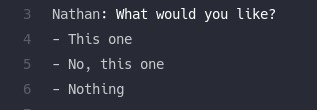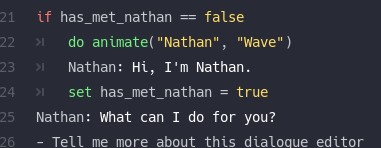5.2 KiB
Writing Dialogue
Navigate to the "Dialogue" tab in the editor.
Open some dialogue by clicking the "new dialogue file" button or "open dialogue" button.
Nodes
All dialogue exists within nodes. A node is started with a line beginning with a "~ ".
A node will continue until another title is encountered or the end of the file.
Dialogue
A dialogue line is either just text or in the form of "Character: What they say".
Dialogue lines can contain variables wrapped in "{{}}" (in either the character name or the dialogue). Any variables you use must be a property or method on one of your provided game states (see down below under Settings, Runtime).
Dialogue lines can also contain bb_code for RichTextEffects (if you end up using a RichTextLabel or the DialogueLabel provided by this addon).
If you use the DialogueLabel node then you can also make use of the [wait=N] and [speed=N] codes. wait will pause the typing of the dialogue for N seconds (eg. [wait=1.5] will pause for 1.5 seconds). speed will change the typing speed of the current line of dialogue by that factor (eg [speed=10] will change the typing speed to be 10 times faster than normal).
There is also a [next] code that you can use to signify that a line should be auto advanced. If given no arguments it will auto advance immediately after the text has typed out. If given something like [next=0.5] it will wait for 0.5s after typing has finished before moving to the next line. If given [next=auto] it will wait for an automatic amount of time based on the length of the line.
Responses
To give the player branching options you can start a line with "- " and then a prompt. Like dialogue, prompts can also contain variables wrapped in {{}}.
By default responses will just continue on to the lines below the list when one is chosen.
To branch, you can provide and indented body under a given prompt or add a => Some title where "Some title" is the title of another node. If you want to end the conversation right away you can => END.
If a response prompt contains a character name then it will be treated as an actual line of dialogue when the player selects it.
For example:
Someone: Here is a thing you can do.
- That's good to hear!
Nathan: That's good to hear!
- That's definitely news
Nathan: That's definitely news
...is the same as writing:
Someone: Here is a thing you can do
- Nathan: That's good to hear!
- Nathan: That's definitely news
Conditions
You can use conditional blocks to further branch. Start a condition line with "if" and then a comparison. You can compare variables or function results.
Additional conditions use "elif" and you can use "else" to catch any other cases.
Responses can also have conditions. Wrap these in "[" and "]".
If using a condition and a goto on a response line then make sure the goto is provided last.
Mutations
You can modify state with either a "set" or a "do" line. Any variables or functions used must be a property or method on one of your provided game states (see down below under Settings, Runtime).
In the example above, the dialogue manager would expect one of your game states to implement a method with the signature func animate(string, string) -> void.
There are also a couple of special built-in mutations you can use:
emit(...)- emit a signal on your game states.wait(float)- wait forfloatseconds (this has no effect when used inline).debug(...)- print something to the Output window.
Mutations can also be used inline. Inline mutations will be called as the typed out dialogue reaches that point in the text.
One thing to note is that inline mutations that use yield won't be awaited so the dialogue will continue right away.
Error checking
Running an error check should highlight any syntax or referential integrity issues with your dialogue.
If a dialogue resource has any errors on it at runtime it will throw an assertion failure and tell you which file it is.
Running a test scene
For dialogue that doesn't rely too heavily on game state conditions you can do a quick test of it by clicking the "Run the test scene" button in the main toolbar.
This will boot up a test scene and run the currently active node. Use ui_up, ui_down, and ui_accept to navigate the dialogue and responses.
Once the conversation is over the scene will close.
Translations
You can export tranlsations as CSV from the "Translations" menu in the dialogue editor.
This will find any unique dialogue lines or response prompts and add them to a list. If a static key is specified for the line (eg. [TR:SOME_KEY]) then that will be used as the translation key, otherwise the dialogue/prompt itself will be.
If the target CSV file already exists, it will be merged with.










